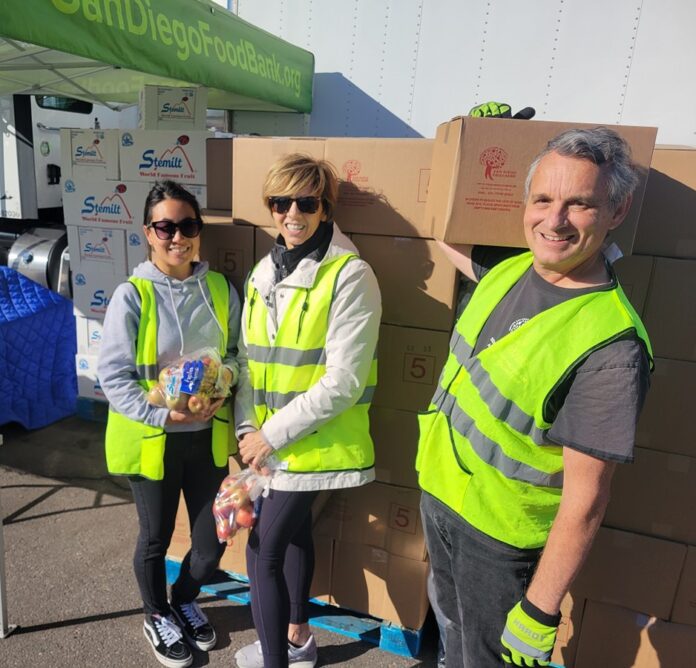
The Jacobs & Cushman San Diego Food Bank distributed 40-pound boxes of nutritious food to more than 2,200 seniors at the MAAC Project Community Center recently. With CalFresh emergency allotments coming to an end at the end of February, it will affect the most at-risk populations in the county, including seniors and working poor families. With increased food costs and inflation, The San Diego Food Bank is working to continue to help residents put food on their table.
San Diego Food Bank Vice President of Operations Vanesa Ruiz said emergency allotments are part of the CalFresh program, nationally Supplemental Nutrition Assistance Program (SNAP).
“Families have been receiving additional benefits through the emergency allotments since the pandemic started,” she said. “So, for a couple of years now, families have become accustomed to getting their regularly monthly CalFresh benefits and an emergency allotment on top of that. The emergency allotment is what is ending soon. The state of California is receiving their last allotment in February which will be paid out to constituents in March. This is why we are trying to get ahead, reaching out to families to let them know that we here you. We know this will be a really difficult hit to most families’ budgets that we serve. And we want to help them. We want them to be aware of the San Diego Food Bank and our North County chapters, so that they know how to find a distribution center near their home and start learning how to access those services before their allotments are removed in March.”
Ruiz said the food bank has a number of programs ranging from providing diapers, college hunger relief programs, all the way up to its senior food programs. She said on Friday, it held one of its food distribution programs that they do each month for seniors only, 60 years and older.
“Friday, we held one of our 70 distributions we do each month in Chula Vista,” she said. “That distribution happens to be our largest. So you picture a large parking lot with thousands of cars in line coming through a very organized drive through system.”
If people are already registered, they go through the receiving process. If they are new, they register on site and leave with their food box that same day, she said.
“That is what you will see at all of our 70 distributions for seniors,” she said. “But, we are specifically calling out this issue because we understand that seniors are going to be the most affected by the emergency allotments going away. That is because they received the largest increase.”
Ruiz said a big thing they added to its website is a “very robust” food locator map so families can go to the website, type in their zip code, and a map will appear with all the distributions that around their home, and also the eligibility requirements for those sites. She said it has distribution sites set up all around San Diego County to make it easier to access food.
“Right now, the senior program has open enrollment, so we have room on the program to bring more seniors onboard,” she said. “Right now, is a great time to bring awareness to a great program that gives them 40 pounds of food every month. There really is a distribution in every pocket of San Diego County.”
Ruiz said there are a couple of programs on the map. The Senior Food program is for seniors over 60 below 150% of the federal poverty level, and the Emergency Food Assistance program, which is available to anyone who is below 230% of the federal poverty level. Ruiz said both programs work where people can self-certify.
“They do not need to bring a proof of income,” she said. “They just need to demonstrate by way of signing that they are eligible for the program. A senior can apply for that one also.”
Ruiz said it is difficult talking to people asking questions about the CalFresh benefits, as they need to plan, decide what to take out of their monthly food budget, just at a time when inflation is sky high.
“This could not have come at a worse time,” she said. “And to those who say that these benefits were not supposed to last forever, that is fine. But what these families were receiving before these emergency benefits were provided was below what they needed to make their food budget. That is why they were still coming to the food bank. To lose this emergency allotment is going to be extremely difficult for these families that we serve.”
Ruiz said one of its programs, the College Hunger Relief program, all colleges and universities in San Diego County are members with the food bank. It provides grants to help provide food and technical assistance to community colleges and universities to help them either start a food pantry on campus, or expand what they are already doing. For example, the Triton Food Pantry at UCSD started small years ago, but now has a “full blown operation,” a very large, nice pantry with staff, volunteers, because they understood there was an issue with student food insecurity.
“To be able to have ready products to go already on campus is really helpful for those experiencing great need,” she said. “Our role is to work with these agencies. Supply them with food and provide them the technical support. I have worked at the food bank for 20 years. My program manager has been here for 9 years. So we have the staff, the knowledge, and experience of starting up pantries, running them, and even during COVID moving to a drive thru model. We try to share those best practices with these colleges because it is no secret that students go hungry.”
“It is more about getting in front of the issue and finding ways to removing barriers to have access to food,” she said.
For more information on the San Diego Food Bank programs and eligibility requirements, visit sandiegofoodbank.org.













